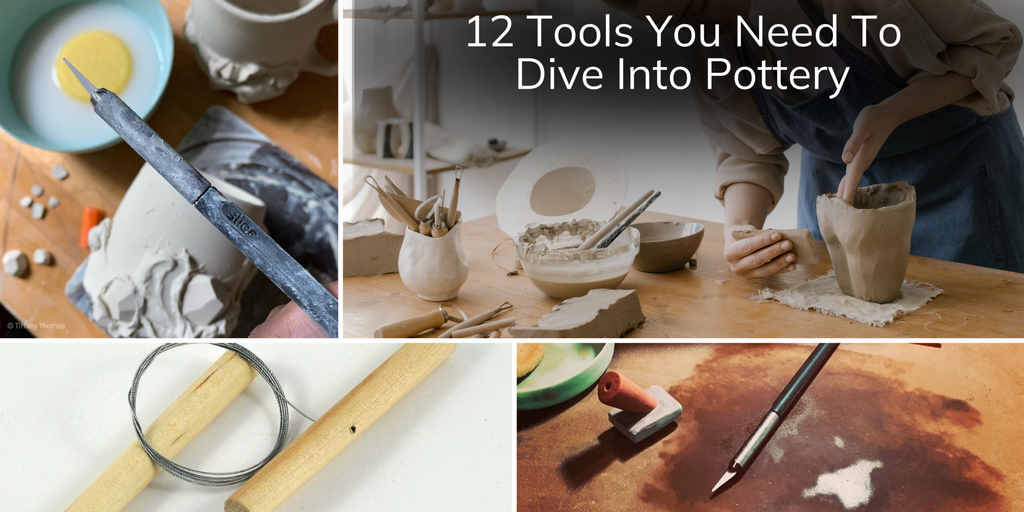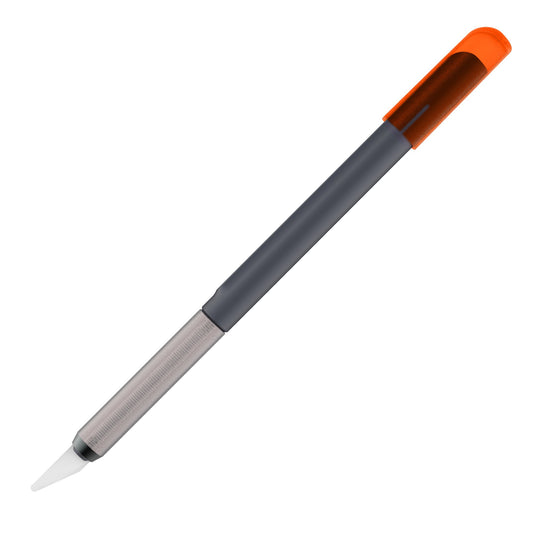Best Pottery Tools You Need To Get Started

Over the past few years, we’ve collectively picked up a few new hobbies to pass the time. Occasionally, said hobbies might develop into a flourishing business, especially on the creative front. Believe it or not, pottery is not only a fun hobby because you love the 1990 movie Ghost, but you can become a genuine potter and make money from your works of art.
Of course, you’ll need high-quality pottery making tools before you embark on this new venture. There are a handful of absolute must-haves in the pottery world. Before purchasing anything, look for the best ceramic tools that are long-lasting, durable, comfortable, and easy to use.
So, without further ado, let’s dive into the best pottery tools you’ll need to create your best work.
What You Need to Start: Pottery Making Tools
- Bladed Tool
- Apron
- Chamois
- Potter's Needles
- Cut-Off Wires
- Fettling Knives
- Ribs and Scrapers
- Loop, Wire, and Ribbon Tools
- Wooden Modeling Tools
- Sponges
- Brushes
- Calipers
- Steps of Making Pottery
Bladed Tool

You’ll find that bladed tools are used in art of all kinds, and, believe it or not, they play an essential role in pottery. They’re great for sculpting, molding, carving, adding intricate details, and smoothing your clay. Since bladed tools, in general, can be a safety hazard, you want to find one that’s not only effective but safe to the touch.
Slice® has a remarkable Craft Knife that ticks off all of the above. Its zirconium oxide blade is more durable than standard metal and lasts longer without rusting or dulling. It’s also finger-friendly® and easy to use.
In addition, the Slice Craft Knife handle is composed of glass-filled nylon with a textured grip that gives you total control over your work. It’s comfortable to hold, ensuring you can work for an extended time without hand cramping or discomfort. This tool is a potter’s dream.
Apron

Aprons are a potter’s best friend, especially if they want to protect their clothing from potential damage. Like in a kitchen, an apron keeps your clothes clean. Dried clay isn’t easy to remove from fabric. Pottery aprons are polyester and consist of a neck loop, a belt with a fastener, and sometimes pockets.
Before purchasing your apron, look for one with adjustable straps. Not everyone has the same build and body type. Secondly, waterproof aprons are always a plus. Lastly, an apron with a split leg allows the potter to sit behind the wheel and work without worrying about adequate leg coverage.
Chamois

So, what’s chamois, you might be asking? Chamois is a thick cloth or leathery material used to smooth and compress the edges of thrown ware.
Other uses for it include smoothing leather-hard pieces. Ensure you dampen your chamois before using it and adequately wash it afterward, so it isn’t on the receiving end of hardened clay.
Potter's Needles

Sometimes, the simplest tools can provide the biggest bang for your buck. Potter’s needles are slender steel tools with needle-like heads and, occasionally, handles. It can execute various functions when crafting clay creations, from sculpting and creating intricate details to parting projects on the wheel and removing clay carefully.
When on the hunt for your potter’s needle, keep quality and safety at the forefront of your mind. Keep an eye out for quality, durable materials that won’t rust or dull. You also want versatile tools that can be used in myriad ways. Finally, a tool that adds value by reducing your work time is a priceless asset.
Cut-Off Wires

Another essential tool for your pottery arsenal is a wire clay cutter or cut-off wires. It helps you work with your clay. For example, you can seamlessly cut a hunk of clay from your block. Additionally, you can slice slabs of clay in half using the tool as you would a knife.
Wire cutters come in different designs, from a simple metal handle with a taut wire between its sides to a long wire coil with two wooden handles. They resemble a wire cheese cutter. Be sure to look for a wire cutter with an effective edge that can cut through clay effortlessly.
Fettling Knives

A fettling knife looks like a regular knife, except it boasts a flexible blade that tapers to a point. It’s a wonderful multi-use instrument for potters. You can remove mold marks, sculpt clay models, use the scratching technique sgraffito, trim, and carve. The blades are usually composed of steel, while the handles are wooden.
While searching for the perfect fettling knife, keep an eye out for tools with truly flexible blades that don’t quickly rust or dull—the higher quality of the blade, the better the experience. You also want a handle that’s easy to hold for an extended period while you work.
Ribs and Scrapers

Ribs (no, not those) are great for smoothing and finishing clay on the wheel. They’re made of silicone, steel, polymer, and rubber. They’re usually somewhat flexible so that you can maneuver them while you work. Ribs are on the smaller side and sit comfortably in the palm of your hand. Consider purchasing a rib tool with a hole in the center. This hole makes it easier to have a solid grip while your fingers are wet. In addition, find one that’s resistant to wear and tear, such as cracking.
Scrapers, however, are used to remove clay instead of shaping and smoothing it like ribs. They’re usually composed of stainless steel and wood. Scrapers are also lighter in weight than ribs. When hunting for a scraper, think about buying one with serrated edges. Besides removing clay, you can create different patterns with its edges. You also want one with sharp yet safe-to-the-touch edges that stand the test of time.
Loop, Wire, and Ribbon Tools

Ribbon and loop tools typically boast wooden or plastic handles. Some also have double ends. You use them to cut clay and remove sections of said clay. They come in different sizes and shapes. Besides clay removal, you can use these instruments to sculpt, trim, carve, create texture, and craft intricate details.
Additionally, loop tools, in particular, are perfect for trimming the feet of wheelwork in its beginning throwing stages, while ribbon tools are utilized on model and thrown projects. Varying loop sizes yield different results. For example, a circular loop results in a rounded look.
Wooden Modeling Tools

Any potter will tell you that modeling tools are a must-have for your pottery endeavors. These can include any wooden-handled tool, from ribs and scrapers to loops, ribbons, and needles. You can create a wide variety of patterns like inlay and sgraffito. Plus, having different tools at your disposal can take your clay creations to the next level. Keep your eyes peeled for variety packs and sets on the market with sturdy, quality implements.
Sponges

Sponges are an effective tool in that they’re multi-purpose, making them an invaluable addition to your pottery toolkit. For starters, they can keep your creations moisturized. Secondly, sponges are great for adding texture or smoothing clay. Having an issue with excess glaze? That’s where your handy dandy sponge comes into play.
If you’re on the hunt for sponges, stock up on multiple kinds, as they’re less resistant to wear and tear than your standard metal or plastic tools.
Brushes

A pottery brush is another tool that boasts a variety of uses, especially concerning the decoration of your clay creations. You can draw images, create fine details, craft different patterns, apply slip, add delicate lines and bold strokes, apply wax resist, paint on underglazes and overglazes, and more.
You might think that any old paintbrush will do the trick, and some higher-quality paintbrushes might get the job done. However, it’s always best to look for brushes that function as pottery implements.
Calipers

You know how regular calipers measure the dimensions of an object? Pottery calipers essentially perform the same function. They measure the inner and outer dimensions of your clay creations, precisely where they’ll join with other parts of a set. You can utilize calipers to measure lids for jars, cup bases, and pitcher bases to match the interior floor of a basin.
Calipers are usually composed of metal, plastic, and wood. If you’re considering adding calipers to your arsenal, be sure to look for some that are durable and flexible so that you can measure a variety of widths and lengths.
Steps of Making Pottery

If you’re a beginner, you might wonder how to tackle something like pottery. First thing’s first, you need lots of clay and water. When mixing water with the clay, be sure its consistency is that of thick mud. Next, you’ll shape your clay by throwing it on a pottery wheel. Shape it from the bottom to the top. Sculpt it in the shape and style of your choosing.
After letting your creation dry for a few days, you’ll want to bisque-fire it to prepare it for the glaze. You don’t necessarily need a kiln to fire your pottery, but it’s certainly helpful. Then, you’ll apply glaze and fire it again. Next, use beeswax or a shellac post-firing to protect it from breaking. Lastly, admire your beautiful creation.
-
Craft Knife
Regular price $18.14 USDRegular priceUnit price per

